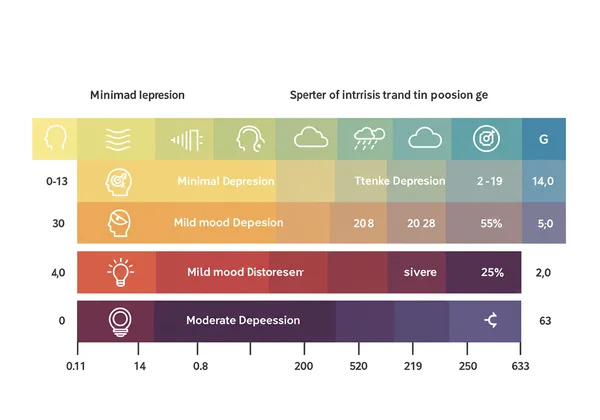BDI Score Meaning: Interpret Your Beck Depression Inventory Results
Receiving a number after sharing your deepest feelings can feel anticlimactic, even confusing. You’ve just completed the Beck Depression Inventory (BDI), and now you have a score. This isn't just a number; it's a key to understanding your current emotional landscape. The core BDI score meaning lies in its ability to provide a structured snapshot of your mood, offering clarity when things feel overwhelming. So, What are the results of the BDI test? Let's walk through this together, translating your score into meaningful insight that can empower you on your mental health journey.
This guide is designed to help you interpret your results with empathy and understanding. If you haven't taken the test yet, you can get a confidential and immediate score by completing our free bdi test. Remember, this is a starting point for self-discovery, a tool to help you reflect on your well-being.

What Does Your BDI Score Mean? Interpreting the Ranges
The Beck Depression Inventory is a scientifically validated self-assessment tool that helps measure the severity of depressive symptoms. Your total score places you within a specific range, each suggesting a different level of emotional distress. It’s important to interpret BDI results not as a final judgment, but as a helpful guidepost. Think of it like checking the weather; it tells you what conditions are like right now, helping you decide how to dress for the day ahead.
Your score is calculated by adding up your responses to the 21 questions. Each question has a scale of 0 to 3, reflecting the intensity of a particular feeling or symptom over the past week. Let’s explore what these different score ranges generally signify.
Minimal Depression (Scores 0-13): Understanding Your Baseline Mood
If your score falls in this range, it generally indicates a state of minimal or no depression. This is often reflective of the normal ups and downs of daily life. Seeing a low score doesn't mean you have no challenges or bad days; it simply suggests that depressive symptoms are not significantly impacting your functioning. This score range reflects a healthy baseline mood.
Consider this range as an opportunity for proactive mental wellness. It’s a great time to continue investing in self-care, strengthening your social connections, and practicing stress-management techniques that keep you resilient. It affirms that your current coping mechanisms are likely serving you well.
Mild Mood Disturbance (Scores 14-19): Recognizing Early Signs
A score in this category suggests a mild mood disturbance. You might be experiencing persistent feelings of sadness, irritability, or a loss of pleasure more often than you'd like. These symptoms may be noticeable to you but might not yet be severe enough to dramatically interfere with your work, studies, or relationships.
Think of this score as a gentle nudge from your mind and body. It’s an invitation to pay closer attention to your emotional state. Are there specific stressors in your life that need addressing? Are you neglecting self-care? Recognizing these early signs is a powerful step, as it allows you to make small, positive changes before the feelings become more overwhelming. It might be helpful to explore your feelings with our confidential assessment.
Moderate Depression (Scores 20-28): Exploring Deeper Emotional Patterns
When a score enters the moderate range, depressive symptoms are likely causing noticeable and consistent distress in your daily life. You may find it difficult to concentrate, experience significant changes in your sleep or appetite, and feel a heavy sense of fatigue or worthlessness. These emotional patterns are more than just a bad week; they are significant challenges.
Receiving a score in this range is a clear signal that your emotional well-being needs dedicated attention. It is strongly recommended that you share these results with a doctor or a mental health professional. This score is not a sign of weakness; it is a courageous acknowledgment of your struggle. A professional can provide a formal diagnosis and work with you to create a tailored support plan. You can gain deeper insights by using our tools as a first step.

Severe Depression (Scores 29-63): Understanding Significant Distress
A score in the severe range indicates that depressive symptoms are causing significant distress and are very likely interfering with almost every aspect of your life. Feelings of deep sadness, hopelessness, and exhaustion can be pervasive. At this level, functioning day-to-day can feel like an immense struggle.
It is crucial to understand that this score is a call for immediate action and support. Please do not go through this alone. Sharing your score with a healthcare professional as soon as possible is an essential next step. They can offer the help and treatment necessary to navigate this difficult period. Your feelings are valid, and effective support is available.
Disclaimer: If you are having thoughts of harming yourself or others, please seek immediate help. Contact a crisis hotline, go to the nearest emergency room, or call your local emergency number.

BDI Mild Moderate Severe: Beyond the Numbers, What Symptoms to Expect
The BDI mild moderate severe categories provide a useful framework, but your personal experience is more nuanced than just a number. The BDI test measures 21 different symptoms, from sadness and pessimism to self-criticism and loss of energy. Two people with the exact same score of 25 could have very different experiences. One person might struggle intensely with sleep and appetite changes, while another might be most affected by feelings of guilt and social withdrawal.
Common Feelings and Thoughts for Each BDI Severity Level
Understanding the symptom context can make your score feel more personal and less abstract. Here’s a general look at what you might be feeling:
- Mild: You might feel more irritable than usual, find less joy in hobbies you once loved (anhedonia), and feel tired without a clear reason. Self-critical thoughts may start to creep in more frequently.
- Moderate: Feelings of worthlessness or guilt can become more pronounced. You might struggle with indecisiveness and have difficulty concentrating at work or school. Physical symptoms like changes in sleep patterns (sleeping too much or too little) and appetite are common.
- Severe: A pervasive sense of hopelessness about the future is a key feature. You may experience a complete loss of energy, withdraw from loved ones, and have recurring thoughts about death or suicide. These symptoms require professional intervention.
The Importance of Context: Your BDI Score is a Snapshot
It's vital to remember that your BDI score is a snapshot of a specific moment in time—usually the past week. It is a highly effective screening tool, but it is not a clinical diagnosis. Life events, physical health, stress levels, and even the time of day can influence your feelings and, consequently, your score.
Your result does not define you. It is a piece of data that provides insight into your current challenges. Use it as a tool to foster self-compassion and as a catalyst for a conversation—whether with yourself, a loved one, or a healthcare provider. The goal is not to label yourself but to understand yourself better.
Your BDI Score: A Starting Point for Self-Awareness
Understanding your BDI score is a significant and empowering first step toward managing your mental health. It transforms vague feelings of being "off" or "down" into concrete information you can act on. Whether your score is low, high, or somewhere in between, it provides valuable feedback about your inner world.
Use this knowledge as a foundation. It can be the start of a conversation with a therapist, a reason to prioritize self-care, or simply a moment of self-validation that your feelings are real. Remember, awareness is the first step toward change. We encourage you to take the free BDI test to gain your own personal insight or to revisit it periodically as a check-in with yourself.

We hope this guide has brought you clarity. What are your thoughts on using tools like the BDI for self-exploration? Share your insights in the comments below.
Frequently Asked Questions About BDI Score Interpretation
What is a normal BDI score?
While "normal" can be subjective, scores in the 0-13 range are generally considered to indicate minimal or no depression. This range reflects the typical emotional fluctuations of everyday life for most people. It's important to focus less on "normal" and more on what feels healthy and manageable for you.
How do you calculate BDI?
The BDI score is calculated by summing the points for each of the 21 questions. Each question is rated on a 4-point scale from 0 to 3, representing increasing intensity of a symptom. When you use an online tool like ours, the BDI scoring is done automatically and instantly, saving you the trouble of manual calculation.
What is the highest score on the BDIII?
The highest possible score on the Beck Depression Inventory-II (BDI-II) is 63. This would mean a person selected the most severe option (a score of 3) for all 21 questions, indicating a profound level of depressive symptoms.
What are the results of the BDI test?
The BDI test results consist of two parts: a final numerical score (from 0 to 63) and a corresponding interpretation of the severity level (minimal, mild, moderate, or severe). These results provide a clear snapshot of your current emotional state, helping you understand the intensity of any depressive symptoms you may be experiencing. You can get your BDI results for free on our platform.